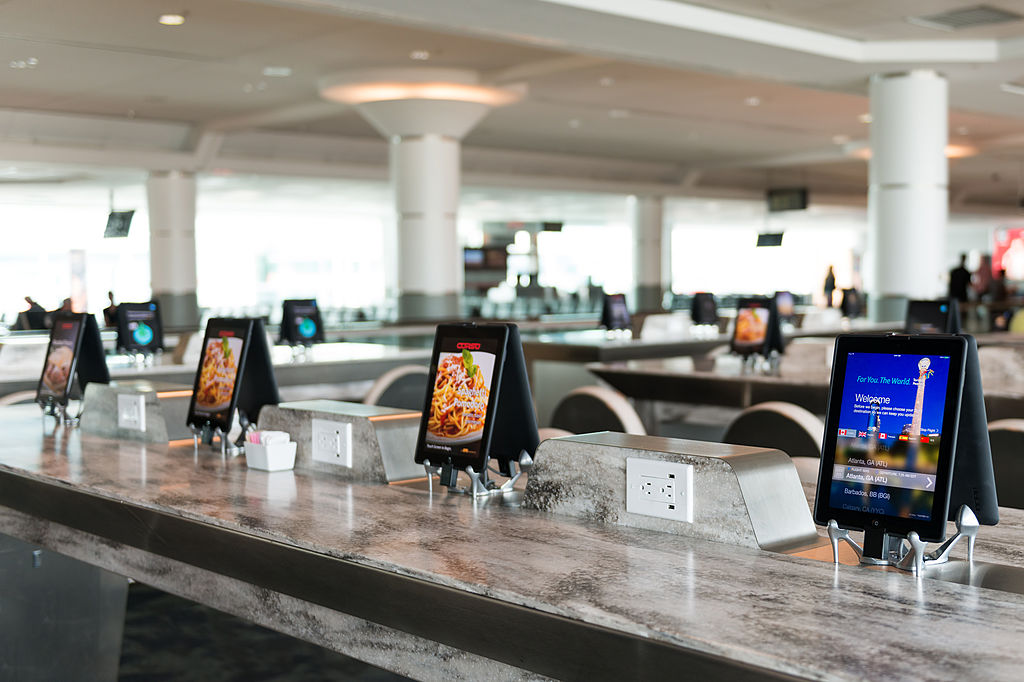Recently, I wandered into an airport restaurant for a meal with friends before our flight. As we took our seats, I was shocked to find that, instead of seeing my friend across the table, I was face-to-face with a bright, blinking screen.
This particular eatery had gone a step beyond the increasingly popular practice of installing a pay-at-the-table device — here, there was an iPad at each seat. They were right at eye level, too, so I had to lean to the side or stretch up out of my seat in order to even see my friends.
Then, as I looked around the airport, I realized that every restaurant had done the same — tables were crowded with iPads, as far as the eye could see. As I later found out, this is becoming a common practice in many airports, which are using the technology to streamline orders and even deliver food directly to airport gates.
While some users might consider this easier and more entertaining than traditional service, my friends and I — “Gen Z-ers” who grew up around technology — were disappointed at how our dining experience was entirely shaped by the iPads. From our conversation topics and ability to make eye contact, to ordering and paying for our meals, we felt distracted and a little inconvenienced as we dealt with payment difficulties, swapped seats due to one battery-dead device, and struggled to flag down one of the few available waiters for assistance.
Now, full disclosure: I grew up in a household that firmly enforced a “no technology at the table” rule. In fact, my parents always emphasized activities like reading and spending time outdoors, meaning that as a child, I was not an early adopter of technology. So I realize I might be in the minority when it comes to my hesitation about tabletop tech, but hear me out — a growing body of research supports why the conveniences of this trend may not outweigh its downsides.
Research has found that the mere presence of a mobile phone at the table — even if it isn’t being used — decreases the quality of conversation and connection between individuals. In one study, those who conversed with someone while technology was present reported lower feelings of empathy, trust, and closeness.
In children, the risks of too much technology use are even more severe. Increased screen time is associated with developmental delays, higher rates of inattention disorders, poor sleeping habits, obesity, and even cardiovascular disease.
While I’m already the person who insists that her boyfriend and friends put away their phones at the table, the iPad incident inspired me to start paying more attention to how often I bring devices to the table. As it turns out, I’m much more guilty of the habit than I thought!
I truly believe that meals are a great opportunity to connect with others face-to-face, so I do try hard to stay present and avoid texting or answering emails from others during that time. But when I started paying attention to my technology use at the table, I found that I often give in to the temptation in unexpected ways.
For example, my weakness (and segue into the bad habit) is when the food comes out. (Confession: I love taking photos of my food.) Pulling out my phone for a quick snap often causes me to glance at the notifications before tucking it away — or worse, to leave my phone next to me on the table, which becomes a constant distraction.
Even though I tell myself that my texts or emails can wait until after the meal, I can’t help but wonder who’s contacting me, or whether that email is important. I even catch myself making excuses, like “the food isn’t out yet,” or “if my boyfriend is using his phone too, then I’m not doing anything wrong” — which, of course, just perpetuates the habit!
Avoiding my cell phone is especially difficult when I’m with a group of people. When everyone else is doing it, I feel left out. Often, it feels like a way to fit in with the group, which is ironic, considering that when our faces are buried in our screens we can hardly be considered “together.”
Although I’m now hyper-aware of how often I use technology at inappropriate times, it’s an addiction that’s hard to kick. I’m still not perfect, but I believe that improvement begins with awareness. And it all feels very worthwhile when I manage to enjoy a tech-free meal, and get to truly connect with the person I’m eating with — even if that person is myself.
Follow us here and subscribe here for all the latest news on how you can keep Thriving.
Stay up to date or catch-up on all our podcasts with Arianna Huffington here.


